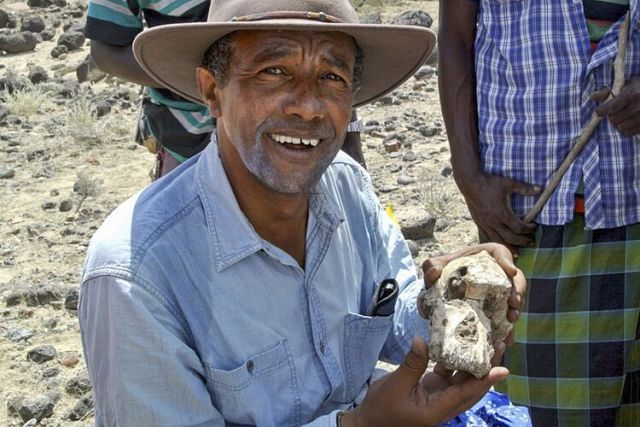Fresh Water Cleveland
The bone hunter: Anthropologist searches the globe to understand the human family tree
Yohannes Haile-Selassie of the Cleveland Museum of Natural History has become perhaps the world’s top hunter of ancient hominins today, boosting Northeast Ohio’s long-time prominence in that field.
Not bad for a guy who started out in history instead of prehistory. In his native Ethiopia, Haile-Selassie became a historian at the national museum, which had many fossils. “It’s opportunity, mostly,” he says of his success. “Seeing the fossils and going to the field and finding them triggered my interest in human origins.”
Haile-Selassie (no relation to his homeland’s long-time emperor) has helped discover three new species of ancient hominins, the tribe that includes our own species, Homo sapiens. He has also found important fossils from our species and from Homo erectus. What’s more, he has shaken beliefs about our evolution.
John Gurche developed this possible face to fit the cranium discovered for a human ancestor called MRD.
“Yohannes is one of the leading paleoanthropologists today,” says Donald Johanson of Arizona State University (ASU), who was working for the Cleveland museum in 1974 while finding the famous Lucy in Ethiopia. “He and his team have made some very important discoveries.”

Yohannes Haile-Selassie in Ethiopia. (Photo courtesy of the Cleveland Museum of Natural History)
“Dr. Yohannes Haile-Selassie is one of the world’s foremost experts in paleoanthropology,” according to a Wikipedia entry. “His continued contributions to this scientific discipline are helping to reshape understanding of humanity’s ancient family tree and change conventional thinking about human evolution.”
The prestigious journal Nature named Haile-Selassie one of the world’s “ten people who mattered in science in 2019.” That’s when he and his team announced finding one of the most complete hominin craniums ever.
When asked to evaluate himself, Haile-Selassie is confident, but not smug. “I could be considered one of the leading anthropologists in our field,” he says. “I made a lot of contributions with our finds, particularly in making some paradigm shifts. How people judge me, it’s up to them.”
Besides Haile-Selassie and ASU’s Johanson, leading hominin explorers based in Northeast Ohio have included former museum head Bruce Latimer and Kent State University professor C. Owen Lovejoy.
Haile-Selassie studied history at Ethiopia’s Addis Ababa University and began in 1990 to dig up fossils. Two years later, he began working toward master’s and doctoral degrees at the University of California, Berkeley.
Starting in 1997 as a graduate student, he found fossils from a previously unknown species, now called Ardipithecus kadabba. That species lived an estimated 5.8 million to 5.5 million years ago—dating nearly back to when humans and chimps apparently diverged.
Yohannes Haile-Selassie examines a hominin fossil in his office at the Cleveland Museum of Natural History
In 2002, Haile-Selassie joined the Cleveland museum as curator and head of physical anthropology. Three years later, he began leading a team that scoured some 500 square miles of exclusive territory each year in Ethiopia’s Woranso-Mille area.
By 2019, the team had found about 230 hominin fossils as well as more than 12,600 fossils from about 85 other species of mammals, including monkeys, pigs, and antelopes.
That year, the team announced perhaps its greatest find so far—nearly all the pieces of a male hominin cranium from the species Australopithecus anamensis.
They called the creature MRD-VP-1/1, or MRD for short. The name isn’t nearly as catchy as Lucy’s, inspired by the Beatles’ “Lucy in the Sky with? Diamonds.” It stands for Miro Dora, the part of Haile-Selassie’s territory where the cranium was found.
After the discovery, team member Beverly Saylor, professor of stratigraphy and sedimentology at Case Western Reserve University (CWRU), led the analysis of plant and volcanic material found with the cranium. Others designed a face for that cranium—considered the likeliest hominin face yet proposed.
Scientists used to think that hominins descended from anamensis through Lucy’s species, Australopithecus afarensis, to Homo sapiens. without much overlap. But MRD appears to be about 3.8 million years old—some 100,000 years younger than the oldest known members of afarensis. So Haile-Selassie says anamensis might turn out to be our more direct ancestor…
“That’s how science goes, a lot of hypothesizing and testing. The more sample size you have, the better.”